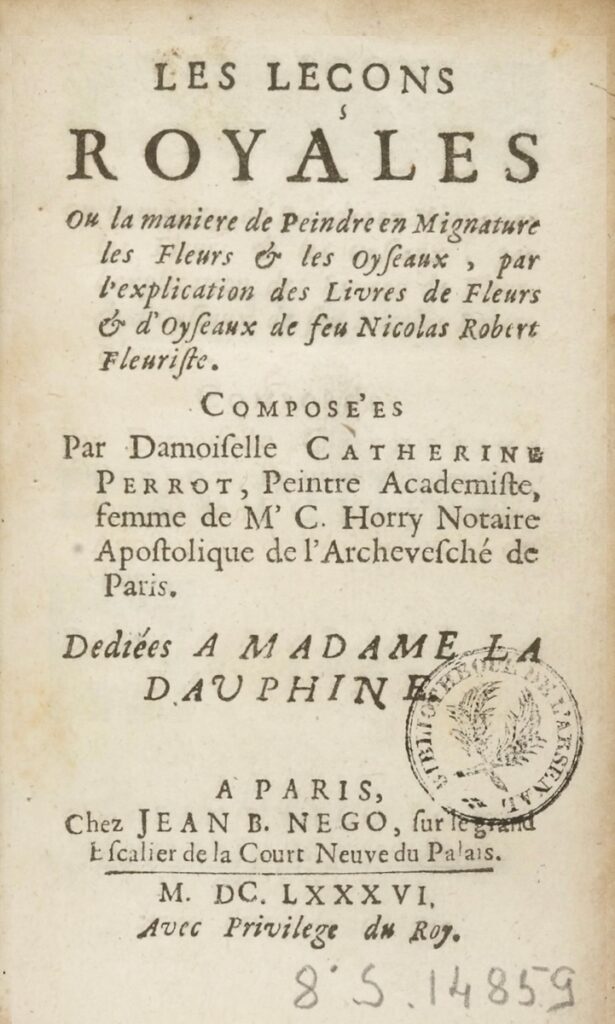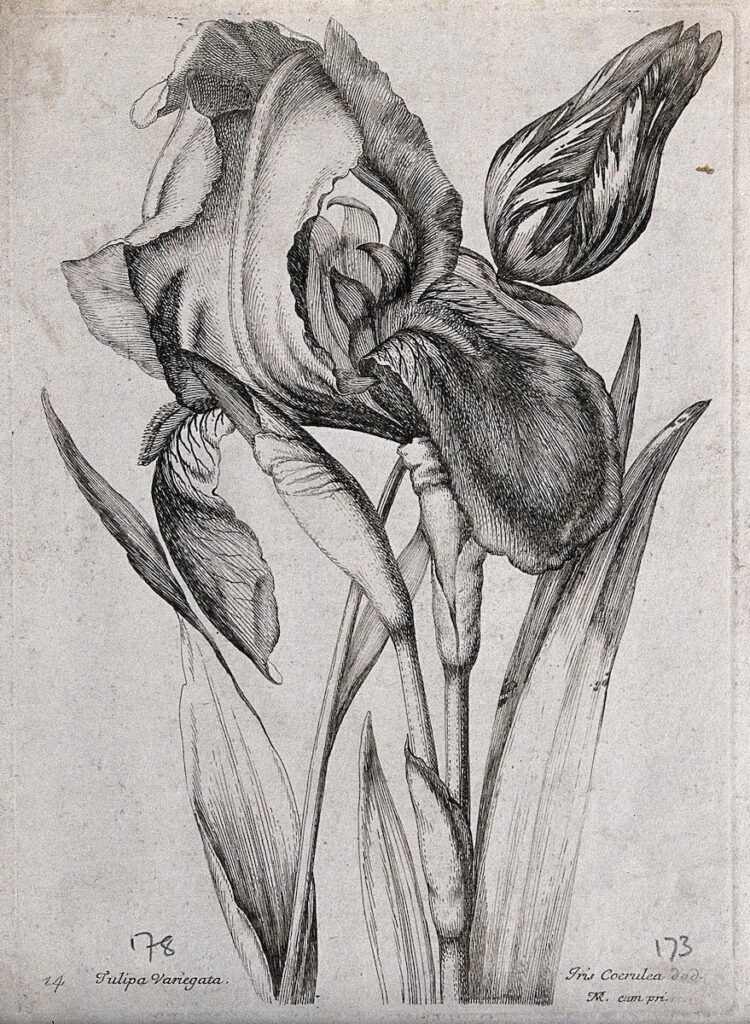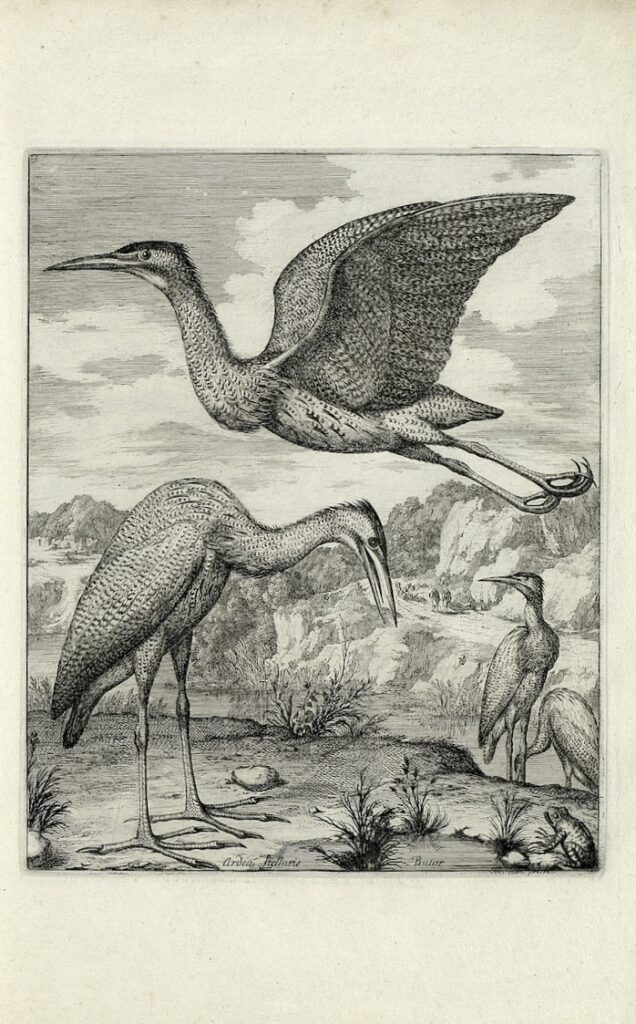Tori Champion
When the French artist Catherine Perrot authored Les leçons royales (The Royal Lessons), her treatise on the art of painting in miniature, in 1686, she became one of the only known women in the early modern period to publish a technical manual on art theory or practice (Fig. 1).[1] Perrot issued an expanded second edition of the text in 1693 with the new title Traité de la mignature, which was reissued in 1725. Her guide, with its focus on the selection and application of color as well as its intended audience of non-professional painters, is not unlike other miniature painting manuals of the period.[2] What sets Perrot’s publication apart is her position as a woman artist and association with France’s Académie royale de peinture et de sculpture, which admitted Perrot as a miniature painter in 1682.

Perrot’s treatise appeared against the backdrop of spirited debates in the Académie regarding the intellectualization of art, the importance of the conceptual over the material, and the relative merits of color and line. The debate over the superiority of drawing versus color was inherently gendered, as color, materially and metaphorically, was bound up with the sensual and the feminine.[3] Concurrently, this period saw record-high membership for women in the Académie. When Perrot was admitted she became the seventh female académicienne, and all six of her predecessors were still alive and thus potentially active members of the community.[4] Not only would this many women artists never again simultaneously be part of the body, but Perrot was also the last one admitted before the Académie adopted a temporary moratorium on female members in 1706; the next would not be admitted for almost forty years.[5]
Considering Perrot’s work within this context requires us to reevaluate traditional accounts of the prevailing discourse within the seventeenth-century Académie that have emphasized the institution’s prioritization of drawing over color and intellectual over manual activity. Perrot seeks throughout her writings to elevate the status of miniature painting, a practice which in the seventeenth and eighteenth centuries entailed small format painting in gouache or watercolor, often on vellum.[6] In prioritizing miniature painting, attention to color, and amateur practice, Perrot’s agenda is not one associated with the Académie at this period in its history. This study will contend that, as such, her writing indicates that the various and diverse interests of academicians were often less homogenous and more materially grounded than has been traditionally recognized.
Perrot based the order and subjects of her manual on two books of prints drawn and engraved by her tutor, the royally-appointed flower painter Nicolas Robert (1614-1685): Diverses Fleurs dessinées et gravées d’après le naturel, and Diverses Oyseaux dessignées et gravées d’après le naturel (Paris: Poilly, 1673). Her employment of Robert’s work imparts her text with a certain authority, constructing a lineage stretching from Robert to herself, and from herself to her students. Perrot offers no instruction in drawing, explaining that the book is “rather for those who have little to no knowledge of this noble art, than for those who have acquired some degree of perfection.”[7] Readers without training in drawing are encouraged to make a calque or tracing of each illustration, whether with lead, red chalk, or charcoal. Perrot then turns to the selection, blending, and application of color, prescribing twenty-four pigments she deems essential to the miniature painter’s palette, from ultramarine, carmine, and gamboge to vermilion, indigo, umber, and lead white.[8]

Perrot begins each passage by introducing the pictured species of flower or bird, describing its principal colors, and then delineating which colors and how much of each one must mix together to form the correct hues. For each part of the flower or bird, she provides two separate mixtures of paint: one for the “sketch,” or base coloring, and another for the “shadow,” normally a slightly darker version of the base color (Fig. 2). For example, “The three large petals of the Iris flower are blue. They are sketched with a very light Ultramarine and darkened with pure Ultramarine…The two large lower petals are crimson; they are sketched with a very light Lake and finished with Lake and Carmine mixed together.”[9] This process is repeated for every specimen in much the same format. For Perrot, the application of color is a rhythmical, repetitive practice built from a carefully developed command of the art of layered color mixing.
Perrot furnishes just one color recipe, offering readers instructions for making their own Iris Green, an act of creation that is messy, laborious, and time consuming. The procedure involves the crushing, soaking, and draining of the leaves of fresh lilies, the incorporation of a chemical preservative, and a month-long drying period before the paint is ready to use. “Should the paint sometime later become moldy,” she writes, “to remove the mold and prevent them from spoiling entirely, you will rub them with your finger, using a little of your saliva, and leave them in the air for a day or two.”[10] There is a marked discrepancy between these procedures—involving patience, bodily fluids, and the probable risk of stained clothing—and Perrot’s assurances to readers that miniature painting can be done with ease and cleanliness.
In its focus on the material qualities and intricacies of color, Perrot’s guide resembles another treatise, published under the titles Traité de mignature and École de mignature across multiple editions, now attributed to the painter Claude Boutet, a non-academician.[11] The earliest iterations of Boutet’s treatise appeared in the decade prior to Perrot’s. Boutet similarly advises tracing when the reader has no training in drawing and moves through a range of subjects by prescribing the appropriate color combinations for each. The two manuals also targeted the same audience. Boutet’s treatise is dedicated to a previous female pupil, and in his introduction, he repeatedly refers to his student practitioners as all-women groups (using the plural pronoun elles). Likewise, Perrot’s texts are dedicated to women who were formerly her pupils. The two publications differ, however, in their proclamation of the author’s identity and professional affiliation. Boutet’s manuals include only his initials and thus were semi-anonymous. In contrast, not only does Perrot include her full name in the titles of both editions, but, adopting a convention of false reluctance which reveals an adept understanding of social and authorial codes, Perrot also prefaces her first edition by acknowledging her desire to use the “long exercise” she has made of miniature painting to serve the public, thereby honoring her affiliations with her distinguished students and the Académie.[12] Perrot intertwines herself and her publications with the institution, and thus her focus on the material aspects of painting and color was tied to a markedly different discourse and context than Boutet’s.
The predominant historical narrative of the early Académie focuses on the academicians’ battle to elevate painting and sculpture to the status of liberal arts following its 1648 establishment in opposition to the guild system.[13] Just as often recounted is the decades-long quarrel of color and line, the most heated period of which occurred in the 1670s.[14] For the proponents of drawing, the question was one of mind over matter: drawing required and exercised the intellect, and gave first form to a conceived composition. The renegade colorists, referred to by their opposition as a “cabal,” argued that it was color dexterously employed in terms of light and shade that resolves an imitation of nature in painting, and thus was superior. For both sides, the art of coloris excluded the manual, “unthinking” labor of grinding and making pigments.[15] Without calling the debate’s occurrence into question, Perrot’s activities as an academician suggest a need to recalibrate our view of the diversity of activities practiced by this group. That Perrot published a color-focused guide to miniature painting for an audience of non-professionals twice under her own name suggests that the Académie tacitly accepted, if not outright supported, such projects.
Perrot reinforces her place at the heart of academic discourse in the second, augmented edition of her treatise.[16] In the introduction, Perrot alters the passage outlining her affiliations to specify that she was received into the Académie by the champion of line himself, “the late Monsieur Le Brun,” as well as the rest of the membership.[17] Furthermore, she sets out a theoretical lexicon (including terms such as attitude, clair-obscur, goût, manière, and esquisse) adapted from texts authored by writers associated with the Académie such as Roger de Piles and André Félibien, while her outlined “five parts of painting”—invention, proportion, color, expression, and position—are abbreviated borrowings from Roland Fréart de Chambray.[18] Incorporating texts central to the theoretical discussions occurring in the Académie, Perrot positions herself within the questions posed and lines of inquiry pursued by Academicians. In her 1999 article on the artist, Élisabeth Lavezzi speculated that Perrot made the theoretical additions to her second edition in response to censure, whether formal or informal, from academic leadership.[19] Though by no means impossible, there exists no documented evidence of such a reaction. I argue instead that the changes made by Perrot reflect more accurately the balanced nature of academic practice and discourse in this period, a balance that she mobilized to elevate the status of miniature painting.

While Perrot’s method of instruction remains unaltered throughout the second edition, she expands the iconographic ambit of her explanations to include landscapes, drapery, and even flesh. Perrot moves with a quiet rapidity from skin tones and shades of hair to the bodies of sacred figures, including Christ, the Virgin Mary, and more than a dozen saints, providing specific color combinations for the flesh and draperies of each.[20] Employing the diminutive and anonymous peasant figures placed in the landscape backgrounds of some of Robert’s bird illustrations as an excuse to discuss the representation of saints, Perrot seeks to expand her reader’s repertoire beyond the genre of natural history (Fig. 3). While by no means catapulting her guide for painting flowers and birds in miniature into the realm of history painting, which had as much to do with size and medium as it did subject matter, Perrot subtly plays with and undermines genre boundaries in these passages, asserting that one can discuss miniature painting using theoretical language and including the religious figures of history painting. By championing this medium, Perrot makes space for miniature painting in academic discourse, seeking to train her readers in the virtuosity of coloris not only applied to natural history illustration but also made fit for “all sorts of subjects.”[21] Perrot maintains that miniature painting can claim the same title of honor (“Queen of the Arts”) as oil painting, as “it encompasses as many things as oil painting and even surpasses it by the brightness and vivacity of its colors…”[22]
Little is known of Perrot’s biography beyond the details contained within her manuals and the Académie’s minutes. The latter document her presence as late at 1693, at which time she appears either to have elected to leave the Académie or to have been expelled amidst a legal matter unrelated to her writings, which are her only surviving works.[23] Perrot’s advocacy of miniature painting, a genre associated with and practiced by women non-professionals as evidenced by her and Boutet’s manuals, necessarily carried gendered associations. Yet, Perrot was one of at least seven miniature painters received by the Académie between 1648 and 1704, including fellow académicienne Anne-Renée Strésor (admitted in 1676), who specialized in religious painting in miniature, and of these miniaturists more were male than female. Perrot does not write of herself as a woman artist, but rather as an academician and teacher. Nonetheless, she raises the status of women practitioners by virtue of her positionality, and she elevates miniature painting by issuing a publication that engages with both theory and practice, situating her manual’s attention to color and its materials within the wider debates then occupying the Académie.
Perrot capitalized on her personal connections, her academic status, and the success of Boutet’s treatise, trading on her enhanced credibility and visibility as a teacher of royal princesses and a member of the illustrious Académie to market her work to a body of genteel clientele. Though, according to our understanding of the seventeenth-century Académie, it would seem that the reputational stakes of publishing a color-focused miniature painting manual as a woman artist during this moment of debate were high, Perrot’s treatises suggest that she in fact saw a viable way to position herself as an academic painter by focusing on the matter of color and the medium of miniature painting. Perrot’s writings productively enrich and complicate our narrative of the nature and strength of the institution’s perceived stances on gender, medium, and materiality, and are thus necessary to our understanding of the early French Académie.
Tori Champion is a PhD candidate in Art History at the University of St Andrews in Scotland
[1] Catherine Perrot, Les leçons royales, ou La manière de peindre en mignature les fleurs et les oyseaux (Paris: Nego, 1686). Two other examples from the long eighteenth century include Anne-Denise Pellichet, “Façon de se servir du Pastel à l’huile de la Veuve Pellichet” (1765), reprinted in Jules Guiffrey, Nouvelles archives de l’art français, IV (Paris: Charavay, 1888), 245-7; and Mary Gartside, An Essay on Light and Shade, on Colours, and on Composition in General (London: Davidson, 1805).
[2] Others include Claude Boutet’s Traité de mignature (Paris: Ballard, 1672), the presumed first edition of a text that was repeatedly reissued, and L’Académie de la peinture (Paris: Loyson, 1679).
[3] Jacqueline Lichtenstein, La couleur éloquente: rhétorique et peinture à l’âge classique (Paris: Flammarion, 1989).
[4] Perrot’s six predecessors were Catherine Duchemin (1630-1698), Geneviève Boullogne (1645-1708), Madeleine Boullogne (1646-1710), Élisabeth-Sophie Chéron (1648-1711), Anne-Renée Strésor (1651-1713), and Dorothée Massé-Godequin (dates unknown, admitted 1680).
[5] Anatole de Montaiglon, ed., Procès-verbaux de l’Académie Royale de Peinture et de Sculpture, 1648-1793, IV (Paris: Baur, 1881), 33-4.
[6] This definition shifted in the eighteenth century to denote miniscule depictions of subject matter in portable formats or on decorative objects.
[7] Perrot, Les leçons royales, 17. Unless otherwise noted, all translations are my own.
[8] For the full list of colors see pp. 12-14 (first edition) and 15-16 (second edition).
[9] Perrot, Les leçons royales, 43-4. See pp. 3-15 for her instructions for purchasing materials.
[10] Perrot, Les leçons royales, 39-42.
[11] The edition primarily consulted for this study was Traité de mignature, 3ème edition (Paris: Ballard, 1678).
[12] Perrot, Les leçons royales, “Préface.”
[13] On the early Académie’s relationship to the guilds, see Nathalie Heinich, Du Peintre à l’Artiste: Artisans et Académiciens à l’Âge Classique (Paris: Éditions de Minuit, 1993).
[14] See Emmanuelle Delapierre and Matthieu Giles, eds., Rubens contre Poussin: La querelle du coloris dans la peinture française à la fin du XVIIe siècle (Brussels: Ludion, 2004); Roger de Piles, Dialogue sur le coloris (Paris: L’Anglois, 1673); Bernard Teyssèdre, Roger de Piles et les débats sur le coloris au siècle de Louis XIV (Paris: Bibliothèque des Arts, 1965).
[15] Paul Duro, The Academy and the Limits of Painting in Seventeenth-Century France (Cambridge: Cambridge University Press, 1985), 11.
[16] On ancien régime copyright conventions see Katie Scott, Becoming Property: Art, Theory, and Law in Early Modern France (New Haven: Yale University Press, 2018).
[17] Catherine Perrot, Traité de la mignature (Paris: Seneuze, 1725), 7.
[18] The adapted texts are Fréart de Chambray, Idée de la perfection de la peinture (Le Mans: Ysambart, 1662), 11-23; De Piles, L’art de peinture (Paris: L’Anglois, 1668), “Pour soulager les amateurs”; Félibien, Des Principes de l’architecture, de la sculpture, de la peinture et des autres arts qui en dépendent (Paris: Coignard, 1676), 459-780. See also Élisabeth Lavezzi, “Catherine Perrot, peintre savant en miniature,” in Femmes savantes, savoirs de femmes: du Crépuscule de la Renaissance à l’aube des Lumières, ed. Colette Nativel (Geneva: Droz, 1999), 229-45, here 243.
[19] Lavezzi, “Catherine Perrot,” 231.
[20] Perrot, Traité de la mignature, 74-84. It is important to note that Perrot only provides instruction for skin tones that would now be broadly characterized as “white,” using almost exclusively carmine and vermilion.
[21] Perrot, Traité de la mignature, 7, 95.
[22] Perrot, Traité de la mignature, 9.
[23] Lavezzi suggests a lifespan of ca. 1620-ca. 1690. For appearances in the Académie’s minutes, see Montaiglon, ed., Procès-verbaux, II (Paris: Baur, 1878), 215, and III (Paris: Baur, 1880), 121. On Perrot’s possible expulsion, see Guillaume Janneau, La Peinture française au XVIIe siècle (Geneva: Cailler, 1965), 337.
Cite this article as: Tori Champion, “Catherine Perrot: Color, Gender, and Medium in the Seventeenth-Century Académie,” Journal18, Issue 17 Color (Spring 2024), https://www.journal18.org/7208.
Licence: CC BY-NC
Journal18 is published under a Creative Commons CC BY-NC International 4.0 license. Use of any content published in Journal18 must be for non-commercial purposes and appropriate credit must be given to the author of the content. Details for appropriate citation appear above.
